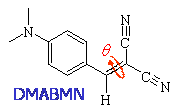

46140-AC6
Modeling Spectroscopic Measurements of Solvation and Solvent Friction
Two unrelated computational projects were proposed for this 2-year grant. The first project involved molecular dynamics simulations of solvation, solvation dynamics, and solvatochromism in gas-expanded liquids (GXLs). This work has now been completed and 2 papers are currently in press reporting the work. GXLs are conventional solvents such as acetonitrile “expanded”, i.e. mixed with up to 90 mole percent, with a near critical gas, most often CO2. Such solvents are of interest both as greener replacements for conventional solvents and for specialized purposes such as nanoparticle fabrication. Our research sought to understand how the solvation energies and dynamics present in a conventional solvent are altered by the incorporation of gaseous molecules and how electronic spectra of probe solutes report on these properties. Experimental studies in our group and others showed what appeared to be extensive preferential solvation of probe chromophores by the liquid component of the GXL. Although preferential solvation is expected, application of commonly used methods for interpreting the experimental data yielded unreasonably large values for the excess fraction of the liquid component. Classical molecular dynamics simulations of a number of solute + GXL combinations, together with a simple model of the spectroscopy provided a clear understanding of how shifts of electronic spectra must be interpreted in order to derive quantitative information about local environment. The gross exaggeration of the extent of preferential solvation by the naïve analysis methods results from both the collective nature of the electrostatic component of solvation (also relevant in conventional liquid mixtures) and from the density variations with composition unique to GXLs. The dynamics of solvation were also studied in detail for one particular solute and polar solvent + CO2 system for which we could obtain experimental data. Simulation – experiment comparisons showed that the dynamics consists of two distinct components. At early times, solvation is accomplished mainly via reorientation of the more polar component present in the first solvation shell of the solute. This portion of the response is essentially complete in 1 ps. The dynamics at longer times (tens of picoseconds at high gas-component concentrations), consists of a solvent sorting process in which polar solvent molecules exchange for CO2 in the first solvation shell of the solute in order to increase the degree of preferential solvation of the excited state. This biphasic dynamics is qualitatively similar to that which occurs in conventional liquid mixtures, but the timescales are shorter because of the greater fluidity of GXLs. Overall, these simulations have provided a satisfying molecular level interpretation of structure and dynamics of solvation in GXLs.
 The second project involves modeling
the isomerization dynamics of malononitriles.
Molecules such as DMABMN, shown at the right, have been previously
studied for two reasons. First the “push-pull”
(electron donor acceptor) character of these molecules provides high nonlinear
polarizabilities of interest for optical device applications. The second characteristic, of primary
interest here, is the fact that they possess short, medium-sensitive
fluorescence quantum yields and lifetimes.
By virtue of this latter property, malononitriles have found use as
probes of “local viscosity” or “free volume” in studies of polymers and various
biological environments. This
sensitivity to environment results from some large-amplitude intramolecular
motion being required for electronic deactivation, but very little is known
about the precise nature of this motion.
The electronic structure calculations we have performed to date indicate
that the dominant motion involved is the double-bond torsion
The second project involves modeling
the isomerization dynamics of malononitriles.
Molecules such as DMABMN, shown at the right, have been previously
studied for two reasons. First the “push-pull”
(electron donor acceptor) character of these molecules provides high nonlinear
polarizabilities of interest for optical device applications. The second characteristic, of primary
interest here, is the fact that they possess short, medium-sensitive
fluorescence quantum yields and lifetimes.
By virtue of this latter property, malononitriles have found use as
probes of “local viscosity” or “free volume” in studies of polymers and various
biological environments. This
sensitivity to environment results from some large-amplitude intramolecular
motion being required for electronic deactivation, but very little is known
about the precise nature of this motion.
The electronic structure calculations we have performed to date indicate
that the dominant motion involved is the double-bond torsion